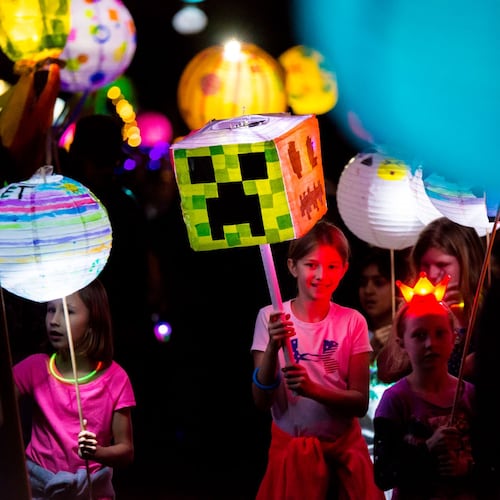“Picture Worlds: Greek, Maya, and Moche Pottery,” at the Michael C. Carlos Museum through Dec. 15, is a visually handsome work of meticulous scholarship that attempts to bridge some of the greatest divisions that museums of art and archaeology confront in terms of addressing ethnically and socially diverse audiences.
The exhibition addresses the ways in which three unrelated cultures approached storytelling through pictorial imagery on terra-cotta vessels.
The makers of the Greek and Maya pottery in this exhibition based their imagery on stories familiar within their cultures, known to present-day scholars through parallel literary texts from the time when the pottery was made. The Moche examples allude to tales known only from fragmentary later references or sheer speculation; the Moche culture left no written documents.
Credit: Photo courtesy of the Michael C. Carlos Museum
Credit: Photo courtesy of the Michael C. Carlos Museum
In the case of the overwhelmingly attention-grabbing Moche warrior duck vessel, this lack of a narrative explanation is particularly frustrating to more audience members than myself. The materials and the execution are compelling, but the meaning necessarily retains a degree of uncertainty.
Organized by the J. Paul Getty Museum, “Picture Worlds” presents challenging questions about the carefully selected objects gathered from major museums by curators David Saunders of the Getty and by Emory University art historian Megan E. O’Neil. For whom and for what purposes were these image-crowded vessels made? How did artists create images that summarized stories without the use of words and how does this choice of visual rather than verbal media alter or open out the narrative?
This is an agenda guaranteed to transfix students of narratology. General audiences (of which there are many) will have to be attracted by the sheer visual power of the pottery and will quite often have to be given enough basic information to allow them to understand the three cultures whose approaches to storytelling are being compared. Even Greece is no longer the widely comprehended topic it once was among more than the classically educated.
Credit: Photo by Mike Jensen
Credit: Photo by Mike Jensen
The exhibition accomplishes its mission of reaching multiple audiences brilliantly, in part by including a chair-filled reading nook and reference library with materials ranging from children’s books to scholarly surveys. Any visitor who finds the exhibition itself appealing will have ample resources and reasons to stay and discuss and think without having to leave the premises.
The canny choice of an episode from the Trojan War for the Greek examples guarantees an amount of prior familiarity and attraction for audiences who might not possess the curators’ intimate familiarity with the arts of the Indigenous civilizations of the ancient Americas — or even with the history of decorated terra-cotta vessels.
The Moche figure nicknamed Wrinkle Face is a chief focus here, and the Maya myths highlighted by the curators may well possess passionate but differently circumscribed fan bases likely to turn out for an innovative exercise in cross-cultural studies. They are, however, likely to be smaller groups than one with an immediate interest that relates to their present-day personal identity. The Maya people possess a living culture that has survived centuries of conquest and colonization.
Credit: Photo by Mike Jensen
Credit: Photo by Mike Jensen
Hence it is significant that “Picture Worlds” is accompanied by “Contemporary Maya Picture Worlds,” a companion exhibition of paintings by five contemporary Maya artists on topics ranging from contemporary Maya spirituality to the armed conflict against Maya people in Guatemala from 1960 to 1996.
The Tz’utujil and Kaqchikel Maya artists in the exhibition deal with issues representative of the more than 8 million Maya people in Mexico, Guatemala, Belize, Honduras and a diaspora that includes communities in Atlanta. The members of the Maya communities worldwide speak approximately 31 different Maya languages.
The exhibition provides detailed explications of the paintings for those audience members who do not share the familiarity others have with the topics portrayed in the paintings. One of the more extraordinary topics and titles is Diego Isaias Hernández Méndez’s “Vista de Perros del Dia de los Difuntos. Barriletes con Espiritus Levantados por el Aroma del Incienso” (“What Dogs See on the Day of the Dead. Kites with Spirits of the Departed Awakened by the Aroma of Incense”). Obviously, the background of this painting is the celebration of the Day of the Dead found throughout numerous countries and cultures in the Americas, but the articulation of the specifics is distinctly Maya.
Throughout the course of this exhibition, the Carlos has featured events designed to appeal to a wide variety of audiences. A highlight of these is on Saturday, Nov. 17, when Cambridge University professor Nigel Spivey lectures on “Epics on Earthenware — How Small Pots Tell Big Stories — and Why.” Spivey is poised to explain how, in the words of the Carlos’ website, “vessels from the Indigenous Americas and ancient Greece convey stories that are as fabulous, complex, emotive and satisfying as a Hollywood blockbuster.”
ART REVIEW
“Picture Worlds: Greek, Maya, and Moche Pottery”
Through Dec. 15 at Michael C. Carlos Museum. 10 a.m.-5 p.m. Tuesday-Saturday, noon-5 p.m. Sunday. Adults, $10; seniors and ages 6-17, $8. 571 S. Kilgo Circle NE, Atlanta. carlos.emory.edu.
Credit: ArtsATL
Credit: ArtsATL
MEET OUR PARTNER
ArtsATL (artsatl.org) is a nonprofit organization that plays a critical role in educating and informing audiences about metro Atlanta’s arts and culture. ArtsATL, founded in 2009, helps build a sustainable arts community contributing to the economic and cultural health of the city.
If you have any questions about this partnership or others, please contact Senior Manager of Partnerships Nicole Williams at nicole.williams@ajc.com.
About the Author
Keep Reading
The Latest
Featured




